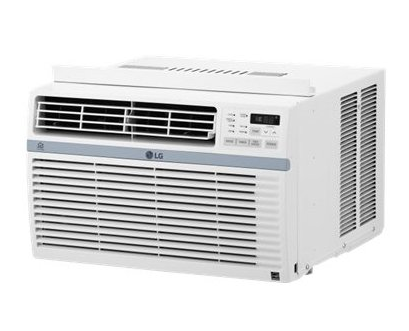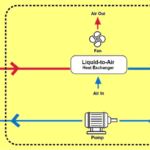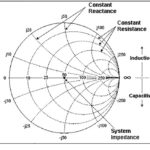We take air conditioning (cooling plus humidity control) for granted, and its development is largely due to one man’s “flash” of insight related to thermal principles and basic physics.
It’s hard for us today, with the ubiquitous air conditioning (A/C) and mechanical refrigeration we enjoy effortlessly, to grasp how A/C changed our lives: it made places like Florida habitable, and it gave us the unimaginable luxury of having access to cooling on demand for food, medication, electronic systems, and science research. It is based on mechanical refrigeration technology, of course, but is much more than that. In Paul Theroux’s novel, The Mosquito Coast, the protagonist (a role played by Harrison Ford in the fairly faithful 1986 movie version of the book) was determined to build an ammonia-based gas-absorption refrigeration plant in the tropical jungle to bring ice to natives who had never seen it and couldn’t imagine what it meant; he loudly proclaimed, “Refrigeration is civilization!” and there is considerable truth to that statement.
The development of air conditioning based on refrigeration principles and technology is largely due to the efforts of Willis Carrier, a Cornell University mechanical-engineering graduate who realized how to adapt compressors and their thermal cycle to cooling air and its moisture (humidity). Although we primarily associate A/C with personal comfort, he was a heating-system engineer for Buffalo Forge Company, working at Sackett & Wilhelms Lithography and Printing Company in Brooklyn, New York on the problem of inconsistent color registration due to temperature and humidity variations which affected paper dimensions, stiffness, and ink absorption.
Air conditioning systems also demonstrate rough equivalent to Moore’s well-known “law” for ICs: while the first A/C system weighed over two tons, occupied an entire section of a department-store floor, and cost the equivalent of tens of thousands of dollars, you can now buy a basic unit (admittedly far less powerful) for around $100, weighing about 50 pounds, and which fits in a window (Figure 1). Of course, there are also smaller units which fit in even compact cars – an amazing yet “taken for granted” advance.

A brief review of heat
Before we look at how air conditioning works, it is useful to review heat concepts. While most electrical engineers are familiar with heat-related principles such as thermal resistance, cooling airflow, forced and unforced air cooling, conduction, convection, radiation, and heat transfer, those aspects of thermal physics are not the only ones needed here.
The second law of thermodynamics is clear: heat (which is a manifestation of “work” in physics) flows only from warmer bodies to cooler ones, in a process called heat transfer. While all substances can absorb heat, refrigerants can absorb heat quickly and in large amounts. Common refrigerants to lesser or greater degrees are air, water, brine, ice, ammonia, carbon dioxide, and fluorocarbons or chlorofluorocarbons (Freon is the best known of these, although its use is now largely restricted due to concerns about its effects when released in the atmosphere).
The energy content of air is called enthalpy, and it is designated in British thermal units (BTUs) per pound or kilojoules per kilogram of dry air in the SI system. A gas gives up its heat when it changes phase to the liquid state (and a liquid gives up its heat when it transitions to a solid); in the reverse process of vaporization, the liquid loses heat as it changes phase to a gas. The specific temperature at which the liquid changes to gas at a specified pressure is defined as its boiling point. The heat that a material gains or loses during condensation, vaporization, freezing, or melting is called latent heat.
In addition to the liquid-gas-liquid phase change used in the A/C system, there is the well-known liquid-to-solid (and reverse) phase change. Removing enough heat from a liquid will cause it to freeze, of course, while adding heat to a solid causes it to melt. This is why citrus growers spray water on their crops to protect them from frost as the temperature drops below freezing, although this action seems counterintuitive to most people: as the water freezes, it gives up its latent heat and warms the fruit, hopefully saving it from harm.
AC parameter dimensional units
In the United States and much of the world, the unit of cooling associated with air conditioning in the British Thermal Unit, or BTU (often written as Btu). A BTU is the amount of heat needed to raise one pound of water by one degree Fahrenheit. In the HVAC industry, BTUs measure the quantity of heat a conditioning unit can remove from a room per hour.
For electrical engineers, it may make sense to relate BTUs to the more-familiar unit of watts. One BTU per hour is equal to 0.293 watts, and one BTU equals 0.293 watt-hours. (Remember, we are talking energy, which is the integral of power, while power is the rate at which energy is used.) To put these numbers in perspective, a small cooling system delivering 3000 BTUs is running at an energy rate of 0.879 kWh.
The metric SI units counterpart to the BTU is the calorie, which is defined as the amount of heat required to raise one gram of water temperature by one degree Celsius. Heat is equivalent to energy for which the SI unit is the joule, and one BTU is about 1055 joules. There is also the strange-sounding dimensional unit of a “ton” of cooling, based on the amount of heat absorbed by one ton of ice melting over 24 hours; one ton of cooling capacity is equal to 12,000 BTU/h.
The next part of this article looks at the invention of modern air conditioning and the technical chart which Carrier devised to quantify the relationship among the many relevant variables.
EE World Online References
Liquid cooling for precise temperature control
Smart Fabric Provides ‘Air Conditioning’ for the Wearer, Adjustable with Mobile App
Energy Efficient, Passenger-Focused Air Conditioning
Solar panels can be used to provide heating and air conditioning
3D-printed impingement cooling chills high-performance chips
Chillers and Heat Exchangers Enhance Looped Liquid Electronics Cooling
Impedance matching and the Smith Chart, Part 2
External References
- Power Knot SRA, “About the psychrometric chart”
- Carrier Corp/United Technologies Corp, “The Invention That Changed the World”
- Carrier Corp/United Technologies Corp, “The Launch of Carrier Air Conditioning Company”
- History Net, “Willis Haviland Carrier: The Man Who Cooled America”
- Alison and Stephen Eldridge, “The coolest inventor: Willis Haviland Carrier and his air conditioner,” Enslow Elementary, ISBN 9780766042162, 1974.
- US Patent US808897A, Jan. 2, 1906 “Apparatus for treating air”
- BHI Plumbing Heating & Air Conditioning, “What Does BTU Mean In AC? The Complete Guide To Understanding BTUs”
- North Cool, “Air Conditioner Sizing Tutorial.
How much air conditioner BTU’s I need?” - Wikipedia, “British Thermal Unit”
- Energy Vanguard, “The Magic of Cold, Part 2 – Intermediate Air Conditioning Principles”
- Southwest Wisconsin Technical College, “Basic Refrigeration Cycle”
- Arch Tool Box. “How Air Conditioners Work”
- Steemit, “The Working Principle Of An Air Conditioning System”
- Parker Hannifin Corp, “HVACR Tech Tip: A Psychrometrics Reminder for the HVACR Technician”




